Precision weapons and laser technology for 21st century warfare
The 21st century battle is going to be fought through various lethal bandwidths of beams than guns and rockets as modern militaries are keen to deploy precision weapon which can smash targets with the pressing of switch buttons than firing costly missiles.
The whole concept is flying an aircraft is getting a reduced option while firing long range missiles are going to be costly for battlefield commanders apart from handling and storing. But pressing a high powered microwave beam or electromagnetic pulse will cost quite cheaper and effective than missiles.
Thus, military forces have been actively developing next-generation weapons that can take warfare well beyond the guns and rockets that populate modern arsenals. Lasers have been a key area of advancement of new generation war technologies.
Recently, stepping out of the realm of science fiction and into reality is the joint US Air Force and Boeing electromagnetic pulse weapon, capable of targeting and destroying electrical systems without the collateral damage often associated with traditional firepower.
Known as the “CHAMP,” or Counter-electronics High-powered Microwave Advanced Missile Project, the American military project is an attempt to develop a device with all the power of a nuclear weapon but without the death and destruction to people and infrastructure that such a weapon causes.
Theoretically, the new missile system would pinpoint buildings and knock out their electrical grids, plunging the target into darkness and general disconnectedness.
The laser is expected to be used for a wide range of high-energy and high-density physics experiments, but its primary purpose is to assist government physicists in ensuring the reliability of American nuclear weapons as they become older.
One of the greatest advantages of the precision weapon is the confidence that it can offer a decision-maker confronted with having to contemplate using force in circumstances where so-called ‘collateral damage’ would be either unacceptable or call into question the viability of continued military action.
Even in high- tempo, high-level-of-violence conflicts, attitudes towards both ‘enemy’ and ‘friendly’ (or ‘neutral’) casualties have undergone a remarkable transformation since the days of the Second World War when, for example, a single air raid could kill tens of thousands of individuals and not raise any significant moral outcry.
Increasingly, conflict scenarios involve the use of force in dense, population-heavy environments, where the negative publicity of misplaced weaponry could have profound implications for public opinion and policy.
Adding to this problem has been a generalised lack of appreciation of how warfare has changed since the Second World War.
On the eve of the Gulf War, for example, critics of proposed military action posited scenarios where tens of thousands of Iraqis would be killed by largely indiscriminate air attacks that would ‘carpet bomb’ population centres, particularly Baghdad.
To give viewers some idea of what a ‘modern’ air war might be like, commentators, ironically, ran footage of Berlin and other German cities after VE Day.
In fact, of course, coalition leaders had no intention whatsoever of using such a level of force against an opponent, recognizing that, given the moral climate of the present day, this use of power simply would not be tolerated by the world community, or even the population of a coalition nation that engaged in such action.
But, after being briefed on the air campaign plan for the Gulf War, coalition political and military leaders were very comfortable with the notion of using precision weapons in attacks deep in the midst of major cities, once they had been assured that the accuracies claimed for such weapons were realistic and not the stuff of an overenthusiastic trade-show sales briefing.
On ‘opening night’ of the Gulf War, for example, Baghdad was struck by two kinds of precision attackers: ship-launched cruise missiles, and air-launched laser-guided bombs.
The extensive use of precision weaponry in the NATO air campaign in Bosnia without any collateral losses, affirmed again that this kind of attack offers decision-makers an option to exert force in circumstances that, just two decades ago, they would not have considered possible.
Because of precision, decision-makers have a freedom to use military force closer to non-combatant-inhabited areas in an enemy homeland (or in enemy- occupied territory) than at any previous time in military history.
They need not risk the broad-area ‘seeding’ of bombs characteristic of earlier wars. In a strategic sense, this can act as a powerful deterrent to an aggressor who, in previous times, might well have felt that the misery of collateral losses engendered by conflict designed to overcome aggression would itself offer some shield or defence against potential action against him.
In both a strategic and tactical sense, precision robs the enemy of the material wherewithal to make war.
Further, since a precision attacker has a higher probability of scoring a hit on a target than a non-precision attacker, there is less likelihood that a target will have to be revisited or repeatedly struck.
While never as ‘surgical’ as proponents might claim, nevertheless, precision attack offers clear advantages in reducing risk to attacking forces, another encouragement for its use in conflict situations.
Additionally, for a nation unwilling to risk military personnel in delivering precision weapons to a target, the somewhat less precise but still highly accurate cruise missile is an acceptable alternative.
Even in cases where precision weapons are used, there is, of course, some risk of collateral damage and consequent public outcry.
Despite targets being clearly justified, this outcry can generate negative policy impacts mitigating against subsequent use of force.
Given the nature of precision weapon warfare, education of decision-makers as to their capabilities and limitations is critically important.
With the rapidly changing state of such technology, it is incumbent that military and defence organisations offer to them opportunities to become acquainted with the broad capabilities of modern military systems.
This is particularly true for precision weaponry, for such weaponry has already demonstrated that, in particular circumstances, cherished notions of how wars are to be fought and the enduring value of such military constructs as the linear battlefield are questionable at best or even archaic.
Decision-makers are particularly vulnerable to looking at military events through the prism of the most recent conflict.
Prior to the Gulf War, for example, the prism for American leaders was Vietnam; accordingly, there was profound scepticism and pessimism that military action could be accomplished in such a fashion as to achieve the coalition’s ends quickly and with minimal loss of life.
The Gulf War showed how radically precision attack had transformed the traditional notion of running a military campaign and, especially, an air campaign.
On opening night of the war, attacks by strike aircraft and cruise missiles against air defence and command and control facilities essentially opened up Iraq for subsequent conventional attackers.
Precision attacks against the Iraqi air force destroyed it in its hangars, and precipitated an attempted mass exodus of aircraft to Iran.
Key precision weapon attacks against bridges served to ‘channelise’ the movement of Iraqi forces and create fatal bottlenecks, and many Iraqis, in frustration, simply abandoned their vehicles and walked away.
In the Gulf War, only nine per cent of the tonnage expended on Iraqi forces by American airmen were precision munitions.
Not quite half of this per centage-4.3 per cent-consisted of laser-guided bombs, credited with causing approximately 75 per cent of the serious damage inflicted upon Iraqi strategic and operational targets.
The remaining precision munitions consisted of specialised air-to-surface missiles such as the Maverick and the Hellfire, as well as cruise missiles, anti-radiation missiles, and assorted small numbers of special weapons.
It was, overall, the laser- guided bomb that dominated both the battlefields, the counter-air campaign against Iraqi airfields, strikes against command and control and leadership targets, and the anti-bridge and rail campaign.
Dumb bomb concept
Against point targets, laser-guided bombs offered distinct advantages over ‘dumb’ bombs. The most obvious was that the guided bombs could correct for ballistic and release errors in flight.
Explosive loads could also be more accurately tailored for the target, since the planner could assume most bombs would strike in the place and manner expected.
Unlike ‘dumb’ bombs, LGB’s released from medium to high altitude were highly accurate. Desert Storm reconfirmed that LGB’s possessed a near single-bomb target-destruction capability, an unprecedented if not revolutionary development in aerial warfare.
In particular, the advent of routine around-the-clock laser bombing of fielded enemy forces in the Gulf War constituted a new phase in the history of air warfare.
These attacks were not classic close air support, or battlefield air interdiction, but, instead, given the level of accomplishment over time, went far beyond the levels of effectiveness traditionally implied by such terms.
Indeed, the vast majority were made in the 39 days prior to the ground operation when the coalition’s land forces were, for the most part, waiting for their war to begin.
Yet the Iraqi army was, in effect, mortally wounded in this time. These attacks, against Iraq’s mechanised formations and artillery, can best be described as a form of strategic attack directed against unengaged but fielded enemy forces, what might be termed DEA: ‘Degrade Enemy Army’.
The combination of laser- guided bombs from F-111Fs and F-15Es, together with Maverick missiles using imaging infrared thermal sensors fired by A-10s and F-16s were devastating, as were laser- guided bombs from British Tornadoes and Buccaneers, and AS-30L laser-guided missiles fired from French Air Force Jaguars.
Particularly deadly were F-111F night ‘tank plinking’ strikes using 500 pound GBU-12 laser-guided bombs.
For example, in one night of concentrated air attacks, 40 F-111Fs destroyed over 100 armoured vehicles. Overall, the small 66-plane F-111F force was credited with 1,500 kills of Iraqi tanks and other mechanised vehicles.
Air attacks by F-15Es and Marine A-6Es in the easternmost section of the theatre averaged over 30 artillery pieces or armoured vehicles destroyed per night.
It is not unreasonable to expect that, in the future, a core competency of an advanced air force will be the ability to provide precision strike, with accuracies less than two metres from an aim point, to any point on the globe within, at most, several hours.
In many ways, the ‘calculus’ of modern warfare has already changed and air power’s ability to contribute to the joint battle has increased.
Not only can modern air power arrive quickly where needed, it has become far more lethal in conventional operations.
In short, the mobility, lethality, and survivability of air power makes it well suited to the needs of rapidly developing regional conflicts.
As technology changes, the nature of the precision weapon will change as well. Increasing standoff engagement ranges is vitally important, as a means of evading ever- changing ground defences and air threats.
The current Joint Stand-Off Weapon is but a first step to even more advanced systems that are likely to emerge.
Already, a long-range forecasting study by the United States Air Force has identified categories of ‘smaller, lighter, agile, more lethal, and more affordable’ air-deployed precision weapon concepts achievable over the next ten to thirty years that could ‘significantly enhance’ the capabilities of the service.
These include advanced cruise missiles to conduct electronic countermeasures attacks, autonomous miniature munitions to stop invading armies, hard-target munitions and robotic micro-munitions to attack deeply buried hard targets.
Adding to it, one can think of hypersonic missile concepts (on the order of 5 km/sec) to strike rapidly and at long range, and precision thermoflux weapons generating long-duration very high temperatures to destroy chemical and biological weapons of mass destruction.
To further degrade the effectiveness of air defences, precision weapons themselves will develop trappings of their launch systems, for example, stealth.
The dividing line between what is now considered a precision-guided munition and an unmanned vehicle will increasingly blur.
Aircraft dispensing such weapons will increasingly become multipurpose ‘battle’ aircraft, capable of being applied to multiple long-range power projection tasks.
The equivalent to the ‘battle plane’ likely will be not the questionably survivable (if even affordable) ‘arsenal ship’ but, rather, the ‘arsenal submarine’.
Intelligence, sensor development, and targeting have always been key issues in aerial warfare, but are now of even greater importance than at any previous time.
Precision weapon employment requires intelligence of a sufficiently high order to enable a desired mean point of impact to be established on an individual target.
In an era where, increasingly, military planners speak of conducting ‘information warfare’ against an opponent, the connection between intelligence, sensor suitability, targeting, and combat operations is obvious.
Target acquisition
In the precision weapon era, there is far greater opportunity to target key nodes of a system for destruction, thus obviating a need for greater military effort and multiple strikes into high-risk areas.
Obviously, to accomplish this requires, again, the closest possible connections between the targeting and intelligence communities.
Targeting also has to examine the appropriateness of precision guided munition use against a particular target.
Some targets, especially those covering large areas such as warehousing, truck parks, large industrial plants, and army formations in the open, where issues of collateral damage are not a concern, may well be more suitable for attacks by aircraft carrying large numbers of dumb bombs, area denial munitions, cluster munitions, fuel-air explosives, and the like.
In the Gulf War, for example, the most feared attacker by Iraqi forces was the B-52, a large capacity dumb-bomb-dropper capable of dispensing up to 38,250 pounds of ordnance.
Though there is a continuing role for the dumb munition, as the above indicates, the reshaping of military affairs that has been wrought by the precision munition will increasingly dominate logistical and strategic planning issues.
The ability to field precision systems into a conflict region rapidly and to good effect-for example, the deployment of the largely experimental GBU-28 deep-earth penetrator in the Gulf War, or the US Army’s Army Tactical Missile System (ATACMS) battlefield missile system.
Though precision weapons deployed from aircraft, helicopters, battlefield missile systems, and ships and submarines off-shore undoubtedly offer a degree of leverage in warfare previously unknown, their cost is a serious concern, and one that must be addressed.
Cost trends in precision weaponry are likely to force an evolutionary ‘survival of the most capable for the least cost’, particularly for those military services with scarce acquisition funding.
For example, by the year 2020, the US Army’s ATACMS will constitute but one-half of one per cent of the total American munitions inventory, but will account for 28 per cent of the total cost of that inventory.
Whether such a system is thus, in fact, a suitable system for mass production is a serious question, given cheaper and more effective long-range power projection options.
Looking at the air warfare case, the overall reliability and costs associated with piloted systems have traditionally been less than the costs associated with operating purely unmanned weapon systems.
In the Gulf War, for example, the total cost of the approximately 2,000 tons of laser-guided bombs dropped by the F-117A force was roughly $146 million; that same tonnage in Tomahawk Land Attack cruise missiles would have been $4.8 billion.
Guided munitions
For the precise guided aircraft bombs are applied into different types of guidance. One of main important guidance system is the laser system.
The laser energy is intercepted by the detector, placed in the bomb nose and the trajectory correction is secured by four aerodynamic vanes (control areas) placed also in the front part of the bomb construction.
The bombs of the series PAVEWAY II were introduced into the armament at the end of the 70th years. These bombs are used for the destruction of different stationary targets.
The maximum bomb range when thrown away from the most convenient height is of about from 10 km till 15 km. The bigger bomb range belongs to the bombs with the biggest mass.
The principle of these types of bombs contains front and rear part, attached to the standard unguided aircraft bombs. There are several variants of these weapon systems, which differ by the used standard bomb.
The 3rd generation of the laser guided aircraft bombs, the series PAVEWAY III which differs from the previous series by the microprocessor, controlled autopilot (is able to satisfy the flight conditions and the regime of throw away) and further on by the more sensitive nose sensor and aerodynamic areas with higher lift force.
The result is the better operation ability and possibility to throw away the bomb from the lower heights, as well as the better bomb range, i.e. till 18 km.
Further works carried out in the sphere of the aircraft bombs modernisation has started in Great Britain, i.e. the series PAVEWAY IV.
The result of these activities can be seen in the most modern bomb of the EGBU type. These bombs should have high accuracy and serviceability during all climate and light conditions, as well as the broad operation ability.
The pilot will have according to the real situation the possibility to choose the guidance regime, by the laser beam and the utilisation of the inertial navigation system with receiver GPS of the 2nd generation.
Due to the combined guidance system and the improved gliding ability of the PAVEWAY IV system should secure the possibility to attack the movable targets or could change the target.
The bomb will have the new combat part with the mass 227 kg, together with “smart (sophisticated) electronic fuse, which would secure maximum destroy effectiveness against the different targets.
The development in France is known under the name BGL (Bombes á Guidage Laser) and the precise guided bombs were introduced in the armament in the year 1985.
As the first modification introduced into the armament was the modification connected with classical fragmentation bomb, having the mass 400 kg.
The bomb length is 3.55 m and the mass 470 kg. The bomb range when thrown away from very high altitude is of about 13 km. At the beginning of the year 1990 in the armament was introduced the bigger variant of the bomb, having the mass 1000 kg.
The weapon system is also known as ARCOLE, the length of which is 4.37 m, the mass is 970 kg and the folded stabilizing areas have the span 1.7 m.
ARCOLE is able to be thrown away from the altitude 7500 m and to cover the bomb range of about 10 km.
The piercing bomb variant which was produced later on and having the mass 400 kg was derived from ARCOLE, as well as was produced the variant of standard fragmentationdemolition bomb having the mass 250 kg.
The late USSR had started the domestic development of the precise guided aircraft bombs, having the name KAB (Korrektirujemaja Aviacionnaja Bomba) at the beginning of the year 1970.
The 1st type was the KAB-500L bomb, introduced into the armament in the middle of the 70th years. The length of the KAB – 500L bomb is 3.05 m, the body diameter is 0.4 m and the total mass is 535 kg.
In contrary with the bombs produced in the other countries, the flight correction is performed by movable aerodynamic areas in the rear part.
Beside the basic arrangement with fragmentation effect, having the mass 380 kg is also known the arrangement with the container arrangement, marked as KAB-500KL.
The laser guided aircraft bomb results in substantial turnover in the accuracy and the manner of ground or navy targets destruction.
With their point accuracy (standard deviation is in several meters), there are also some disadvantages. Beside their relatively higher price there is the necessity of every target irradiation during the total time of flight of the bomb.
Therefore there had been searched another solution, which was discovered in the USA after finishing Desert Storm operation, i.e. by the new system marked as JDAM-(Joint Direct Attack Munitions).
The ongoing revolutions in aerospace and electro-optical technology will undoubtedly continue to shape the future evolution of the precision guided munition, nowhere more so than in efforts to overcome current limitations on precision weapon use imposed by weather conditions.
Two notable development efforts designed to produce acceptable accuracies in bad-weather conditions are the Joint Direct Attack Munition (JDAM), and the Joint Stand- Off Weapon (JSOW), both of which employ Global Positioning System satellite navigation terminal guidance as their primary means of achieving precision.
Both JDAM and JSOW will generate their own families of precision munitions, with widely varying warhead and mission options (ranging from penetrating hard targets to dispensing submunitions in anti-armour attacks) and JSOW even offers a powered variant that renders it, in effect, a small cruise missile.




